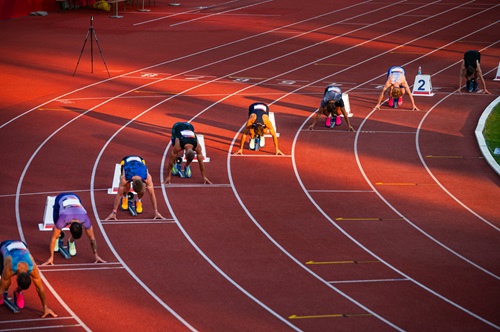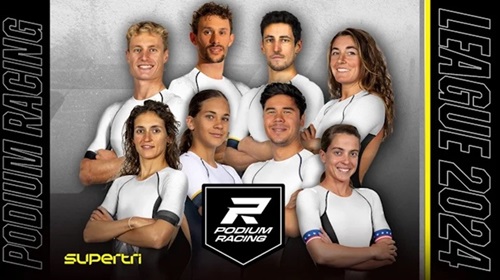
The formula works: Drive participation in a sport by showcasing it at the highest level possible, then follow it up with in-person events that both provide reminders of how exciting that sport is – and generate economic impact for the hosting cities. Pretty soon, kids will be begging their parents to register them for lessons.
Nowhere is that more evident than at the Olympic level. And now that the Paris Games are in the rear-view, event owners will be capitalizing on the fervor to keep the momentum going.
From what are called the “big four” sports (gymnastics, track & field, swimming/diving and beach volleyball) to relatively new-to-the-Olympics pursuits like climbing, skateboarding and surfing, audiences are tuning in, kids are getting inspired and event owners are ready to reap the benefits.
Of course, it never hurts that ongoing events will make sure the sports stay squarely in the public eye. For example, the Gold Over America Tour (GOAT) beginning in mid-September, is not a competition but a showcase, or, as the website puts it, “a pop concert-style spectacle that will showcase the athletic brilliance and championship journeys of Simone Biles and cast members Jade Carey, Jordan Chiles, Paul Juda, Peng-Peng Lee, Brody Malone, Katelyn Ohashi, Stephen Nedoroscik, Fred Richard, Joscelyn Roberson, Mélanie Johanna De Jesus Dos Santos, Casimir Schmidt and others.”
The event will travel to arenas from coast to coast, and cities will be able to expect some major economic impact.
 And as Bleacher Report notes, it’s a sport that is almost custom-made for a theatrical presentation: “Gymnastics gives viewers everything they could want from a sporting event. There are phenomenal athletes, compelling stories, pageantry and flips through the air that make for cool highlights. The fact that judges determine who wins and who loses cannot even ruin the beauty of gymnastics.”
And as Bleacher Report notes, it’s a sport that is almost custom-made for a theatrical presentation: “Gymnastics gives viewers everything they could want from a sporting event. There are phenomenal athletes, compelling stories, pageantry and flips through the air that make for cool highlights. The fact that judges determine who wins and who loses cannot even ruin the beauty of gymnastics.”
But it’s far from the only event capitalizing on the momentum of the Games in Paris. Most recently, the Manhattan Beach Open Presented by AVP brought the excitement of beach volleyball to the Manhattan Beach Pier. The Chicago Open will follow. (As a side note, this marks the 34th year of the tournament in Chicago, which has become a Labor Day favorite.)
In addition, USA Volleyball offers a number of events, including Beach National and Regional Qualifiers. In addition, the organization’s USA Volleyball Beach Tour culminates with the USA Volleyball Beach National Championship. This tournament provides young beach athletes an opportunity to compete for a national championship. Four divisions compete at the summer-long event, 12U, 14U, 16U and 18U. Competition this year concluded just prior to the Olympics.
Track & field and road racing events, an absolute powerhouse for viewership at the Olympics, are contested all year long at marathons nationwide (as well as worldwide). Additionally, the Diamond League, an annual series of 15 elite track & field competitions held around the world (including in the U.S.), keeps the fire lit on the sport, even if the Olympic cauldron isn't burning. Additionally, it is likely that, given the fact that many of Team USA’s stars were high school and college standouts, more attention will be given to high school and college competitions.
The World Indoor Track & Field League, a new organization, will debut in 2026, with 24 teams representing cities around the globe. If the event takes off, it could be a good bet for drawing crowds after the 2028 Games in Los Angeles. (Worth noting: Track & field is a perennial top 10 finisher in the National Federation of State High School Association’s participation survey.)
Soccer is another favorite Olympic sport in terms of viewership; after the Games have concluded, domestic audiences can catch USL and NWSL action, as well as watching Team USA compete throughout the year.
Some events have met with more success than others in trying to set up showcases to harness the Olympic momentum. The International Swim League, for example, promised fast-paced race sessions, featuring teams of elite swimmers from around the world. But FINA, the international governing body for swimming, contacted swimmers and urged them not to affiliate themselves with the unsanctioned ISL. More problems occurred later when swimmers were not paid their promised salaries, leading to boycotts. The ISL ended its run in March of 2022.
 Expect the relatively newer sports in the Olympics, including surfing, skateboarding and competitive climbing, all of which appeared in Tokyo (and which will be featured again in Los Angeles in four years), to also grow in popularity. Skateboarding, for example, has events that are accessible to beginners, as well as elites.
Expect the relatively newer sports in the Olympics, including surfing, skateboarding and competitive climbing, all of which appeared in Tokyo (and which will be featured again in Los Angeles in four years), to also grow in popularity. Skateboarding, for example, has events that are accessible to beginners, as well as elites.
And it’s certainly not just the Summer Olympics that see a bounce in sports participation. In the Winter Olympic years, figure skating experiences an enormous boom, and that fire is additionally stoked by competitive events featuring Olympians as well as other elite contenders. At the same time, showcases like Stars on Ice, Disney on Ice (or even the old Ice Capades, for those who can remember that far back) have continued to keep the interest high.
Facilities can also be built in response to interest, another way of maintaining sports' momentum. After all, while not every destination can have a beach with surfable waves, surf parks provide an excellent alternative. In fact, according to The Surf Park Summit: “the primary revenue stream for surf parks is user fees, with surfers paying for time in the wave pool. Additional revenue can be generated through equipment rental, such as surfboards and wetsuits, as well as food and beverage sales. Surf parks may also host events, competitions and lessons, which can generate additional income.
And as the popularity of surfing continues to grow, surf parks are likely to become more common around the world. New technology and innovations in wave generation can improve the experience for surfers and reduce the operating costs for surf park developers.
 The surf park industry is expected to reach $3.1 billion by 2025. With unique and exciting experiences on offer, surf parks are attracting investment and are likely to continue to grow in popularity for years to come. Surf parks may also become a more sustainable and eco-friendly option, using renewable energy sources and reducing water consumption.”
The surf park industry is expected to reach $3.1 billion by 2025. With unique and exciting experiences on offer, surf parks are attracting investment and are likely to continue to grow in popularity for years to come. Surf parks may also become a more sustainable and eco-friendly option, using renewable energy sources and reducing water consumption.”
Triathlon medalists, meanwhile, will be featured in the supertri League, which kicked off its competitions in Boston on August 18. (It also visits Chicago on August 25.)
Climbing can also expect an uptick of interest. According to the Climbing Business Journal, at the end of 2023, a total of 622 climbing gyms were open in the United States, compared to 353 gyms in 2014. That’s a 76 percent increase in less than a decade.
The average annual revenue per climbing gym is around $974,337, according to a 2023 report from Gitnux, a “clear indication the rock climbing industry is thriving.” And the activity still has more room to grow. Fitness clubs can convert underused indoor spaces to climbing areas, in order to capitalize on the boost the sport is experiencing.
There is widespread mainstream sponsorship buy-in to a number of extreme disciplines, from climbing to Formula 1 to cliff diving to breaking to plenty of others. Energy drink manufacturer Red Bull, for example, sponsors series for all these sports (and more).
 With school starting soon (and in some areas, with kids already headed back to class), the time is prime to promote high school sports.
With school starting soon (and in some areas, with kids already headed back to class), the time is prime to promote high school sports.
“Undoubtedly, the enthusiasm of the past two weeks in Paris will be a boost to the almost eight million participants who will begin competition in high school sports this fall,” notes Dr. Karissa L. Niehoff, Chief Executive Officer of the National Federation of State High School Associations (NFHS).
In other words, if kids have access to a screen to view the Olympics, they’re going to have a dream when the Games are done. Whether viewers see athletes who are vaulting, running, cycling, shooting arrows, riding on horses, dueling with rapiers, playing table tennis or handball – or anything else, it’s a sure bet those young viewers will want to learn more. And that means event owners need to be ready.

